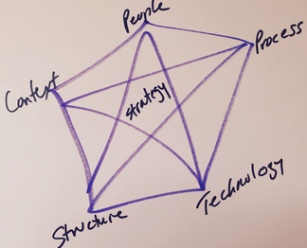MAPPING ORGANIZATIONAL DESIGN: PART ONE
/When I first starting teaching the MBA course, “Organizational Analysis and Design,” I went in search of a tool to offer the students as they learn to describe organizations and think about organizational redesign. I’ve generally had the students read some version of Jay Galbraith’s work (Galbraith Star Model) and pieces of Nadler and Tushman’s “Mapping organizational Terrain.” One of the first things we do is look at the two models and think about how they fit in the students’ organizations. Quickly it’s clear that these models were written when technology was considered more like plumbing and less like a strategic opportunity for organizational design (or possible ways to augment or fully-substitute for human work).
Adding Technology to Traditional Organizational Design Frameworks
Organization design’s goal is to support the strategy of the organization. Give me a strategy and we can work out a design. Galbraith and Nadler and Tushman are foundations, but we need something that matches modern organizations, while is still basic enough to have top of mind for evaluating or creating thoughtful proposals, making sure you don’t let a particular dimension get dropped from discussion, or getting your thoughts together for an unexpected job interview.

My students and I end up drawing this image almost every class session. For shorter courses, like my sessions in the 21st Century Management program, I give them a stack of templates. At some point I break out one of my Skwish toys to demonstrate interconnections across different organizational design dimensions.
I’m now going to turn this post over to past student, Shandon Fernandes, for the real story:
From a Student’s Perspective
Star Framework Dimensions
- People – Psych 101 material. How do people behave (whether or not they are in an organizational setting)? People generally like rewards and don’t like punishments. Different generations may have different preferences.
- Process – This dimension allows for an evaluation of organizational policies. Hiring, performance, pay, training, any policy or procedure, big or small.
- Technology – Technology forms a crucial and inevitable part of the STAR Model. Technology has not only transformed the nature of and specializations of jobs but offers organizations an effective tool to evaluate and transform their operations when used appropriately. Ranges from the kind of office furniture you have to electronic communication to robots and artificial intelligence.
- Structure – Structure lays out the location of decision-making and authority. This is where team-based strategies and org charts are considered.
- Context -- Context is the linking point to many other MBA courses. Is this an international business or a local one? Is the market trending up or down?
Don’t Change Everything All At Once
Terri adds: You also want to avoid trying to change everything all at once, either when playing with a Skwish or implementing all encompassing enterprise software -- I use FoxMeyer’s failure an example.
End of Part One
In Part Two, Shandon applies the star framework to a recent customer experience. Terri and Shandon work out some possible improvements and demonstrate using the template.
Shandon Fernandes is a currently pursuing an MBA at Santa Clara University and is specializing in Leading Innovative Organizations. A Political Science graduate, Shandon has always had an interest in the structure and functioning of government organizations. She has previously served as a Research Officer for a Diplomatic Mission in Mumbai.







